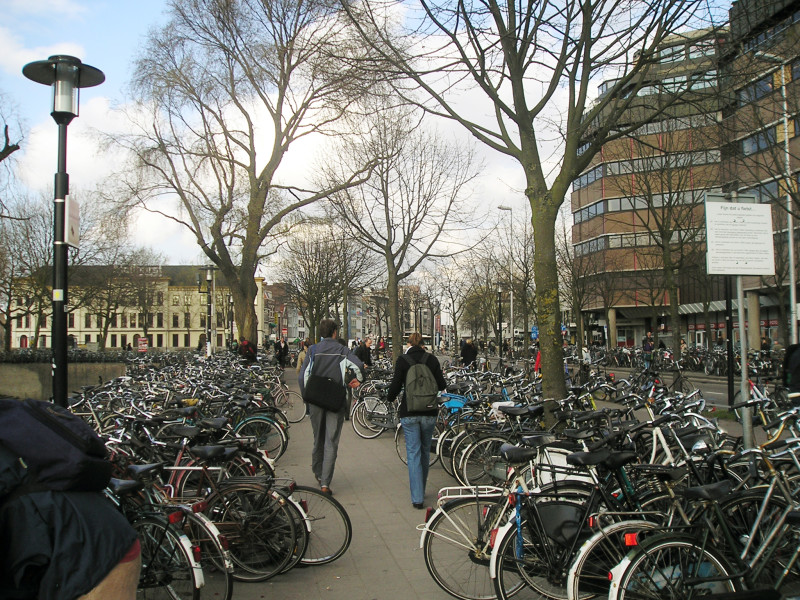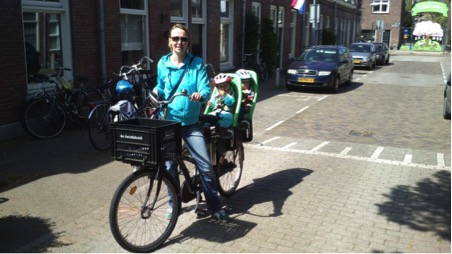Brian Johnston was lucky enough to live in one of the best biking cities in the world for eight years. He’s been keeping tabs on developments in Auckland from a distance, and making comparisons…
They say that the best things in life are free, and after having lived in The Netherlands I can confidently say that the Dutch know pretty well how to live that adage to the max. A nation of traders with a nose for a deal, no nonsense, and a strong belief in the right of all to do their own thing so long as it doesn’t impact on others. What has that got to do with riding a bicycle you might ask? Well, nothing – and everything. Cycling is cheap, for starters.
But the success of cycling in The Netherlands is a classic chicken-and-egg scenario. Which came first, a cycling culture or the infrastructure to enable cycling? And what can New Zealand learn from it?
As a Kiwi, at first I can see more differences than similarities between Dutch and Kiwi cycling culture. Cycling is completely integrated into Dutch culture and couldn’t honestly go much further. Cycling culture in Auckland has huge potential and is making some great early steps now but can still improve out of sight – but how?
Let’s start with a few ‘compare and contrasts’ between Utrecht, the city I lived in for 8 years in The Netherlands, internationally recognised as a best-case example – and Auckland. (NB these stats are dredged off the internet and are just to paint a picture).
| Utrecht (NL) | Auckland (NZ) | |
| Population | 311,000 | 1,400,000 |
| Population density (per km2) | 3250 | 2500 |
| % of short journeys | Bicycle: 43% (< 7.5km) | Car: 67% (<5km) |
| Cars per 1000 population | 528 (NL) | 680 |
Utrecht has a sense of humour about its status as a top cycling city. It hosted the start of the Tour de France in 2015 (for which honor they paid the organisers a generous fee – remember this is the Tour de France right? It’s supposed to be in France!). That gives you an idea of how fanatical the Dutch are about cycling, and of course they made a video to celebrate, but it’s not quite what you might expect:
People have been cycling en masse across The Netherlands since the 1890s, and for good reason. To state the obvious, the country is flat as a pancake, which not only makes building railway lines (and roads) extremely easy, but also means that cycling is a breeze, so long as the wind is in your favour. Like many cities in Europe which grew well before the invention of the car, Dutch city centres are compact which makes getting around very easy too.
Then there’s the equipment. The typical Dutch city bicycle (stadfiets) is strong and heavy so it can take endless abuse and lasts for years, and students can use the rack on the back to hitch a ride with a friend. It has a low seat and high handlebars so you can ride it in a more upright position which is good if you are wearing your work clothes, for example – and, because the country is so flat, no sweaty hills. The bike often has only one gear – again, no hills so why would you need gears? And it usually looks terrible and is accompanied by a massive chain and lock to prevent junkies from stealing it.
For a stadfiets, the main cost is maintenance. I had mine for 7 years and probably spent 5 times the initial cost of the bike on maintenance. They have a rough life; ridden in all conditions from torrential rain to icy roads and roads de-iced with salt. They are unceremoniously parked (dumped) in any available space in the city centre, and frequently topple over with others in tangled piles of bikes. Perfect for daily use. But how many people who are into cycling in Auckland have and use a bike like I just described?

Despite so many Dutch cyclists riding around on what might look to us like dodgy bikes, while cycling in The Netherlands you feel very safe. There’s no law requiring cyclists to wear helmets. The Dutch would riot (or more likely peacefully protest by ignoring the law) – helmets mess up your hair! But when cycling in The Netherlands I felt completely safe from cars, trucks, buses. So many kids get to school by bike, and we regularly took our toddlers to daycare by bike. The minor accidents that occurred were actually with other cyclists, and how much damage can you do when you are both going 20km/hr?
(By contrast, when I was cycling in Auckland in the 2000s, it was a risk-taking thrill; every successfully completed ride was a rush. The regular near-misses and occasional crashes with cars only reinforced this feeling. For me, cycling – even commuting – in Auckland was sport. There were only a few pockets of safe cycling around like the Eastern Bays, and city parks like the Domain and One Tree Hill. It is great to hear that this is starting to change, thanks to the actions of you guys!)

In The Netherlands, cycling is primarily a form of transport, and is taken just as seriously as cars and trucks, buses and trains. Everyone recognises that it is the most effective form of transport if you need to travel distances of up to 5km – it is faster from door to door than anything else. To that end, the Dutch cities take cycling infrastructure very seriously.
Cycling is completely integrated with public transport systems too. The bike traffic to the station in the morning is fierce, but it flows smoothly, and there is no noise or air pollution. It’s a pretty nice experience. Utrecht is currently building an underground bicycle parking area below the main train station which will hold 12,500 bikes (next door to the one in this next video). The new bike parking areas are necessary because of the success of the bike paths and separated paths that have been built and improved over decades.
In addition to making it easy to travel by bike, since the 1970s Utrecht has had a clear policy to try and discourage people from driving into and through the central city. It’s hard to find parking, expensive to park, and there is a maze of one-way roads which only cyclists can use in both directions. It can easily take 2-3 times as long to drive across town as it take to cycle. So why would you bother to drive?
Now, Auckland is a whole different kettle of fish, as you all know: spread out, with harbours on both sides and hills throughout. Could a cycling culture like Utrecht’s be achieved?
Looking at Auckland from afar, I have to say that there is some progress at long last. The cycleway along the NW motorway and into Grafton Gully is a landmark achievement, and Lightpath is eye-catching and cool. It’s great to see the beginning of a loop around the central city, and ways for commuters to get there (like the Glen Innes to Tamaki cycleway that will be built for the eastern suburbs).
But to my mind, what is most needed is safe cycle paths connecting the areas of highest population density. This is where the people are, who can be encouraged into cycling as a form of transport, and you can start to build a network.
Getting these safe paths constructed will mean that the car will need to make a compromise – for example, some parking spaces etc will need to go. For enough people to switch to cycling for short trips, you need the right combination of cheaper/ faster/ easier/ healthier and safer to edge out the car. And that will be a challenge.
Then again if you look closely at The Netherlands, it hasn’t always been so bike-friendly. The Netherlands was once as car-choked as Auckland seems today. The Dutch got their bike-friendly paradise by really fighting for it. If they managed to turn things around and make their cities more liveable, then we can too.
— Brian Johnston
https://twitter.com/fietsprofessor/status/603134652946194432




